Strategic Management in Organisations: Siemens Change Program Analysis
VerifiedAdded on 2022/10/10
|11
|2786
|124
Report
AI Summary
This report provides a comprehensive analysis of Siemens' strategic change programs, focusing on the key factors driving organizational transformation. It begins with an introduction to Siemens and its diverse business segments, followed by a discussion of the impact of future environmental forces, including megatrends such as globalization, climate change, digitization, demographic shifts, and urbanization. The report identifies critical factors influencing change, such as unmet growth targets and competition, and explores Siemens' digital transformation initiatives, including the implementation of software like Teamcenter to automate key departments. It examines the context of the strategic transformation, including the need to address changing customer expectations and financial aspects. The report further explores the future of the organization, analyzing strategic measures and the 'Vision 2020' focusing on the value chain of electrification. It also analyzes environmental aspects, including political, economic, social, and technological factors affecting Siemens' global operations. The report evaluates the steps taken and planned to influence the adoption of Siemens' future strategy, emphasizing digitization and the creation of an 'ownership culture', and addresses the challenges faced in implementing the strategy. The analysis incorporates insights from relevant literature and research, providing a detailed overview of Siemens' approach to strategic management and organizational change.
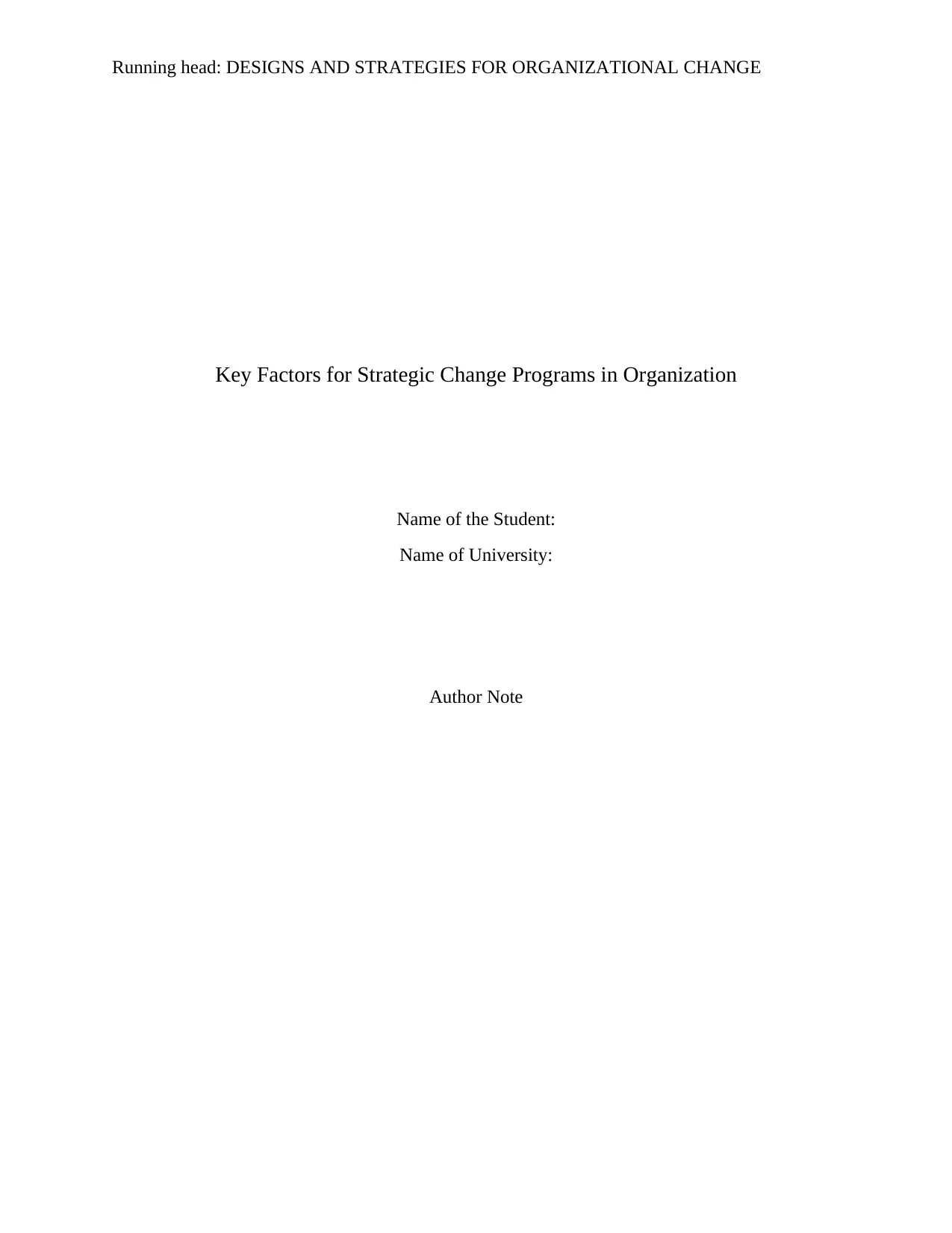
Running head: DESIGNS AND STRATEGIES FOR ORGANIZATIONAL CHANGE
Key Factors for Strategic Change Programs in Organization
Name of the Student:
Name of University:
Author Note
Key Factors for Strategic Change Programs in Organization
Name of the Student:
Name of University:
Author Note
Paraphrase This Document
Need a fresh take? Get an instant paraphrase of this document with our AI Paraphraser
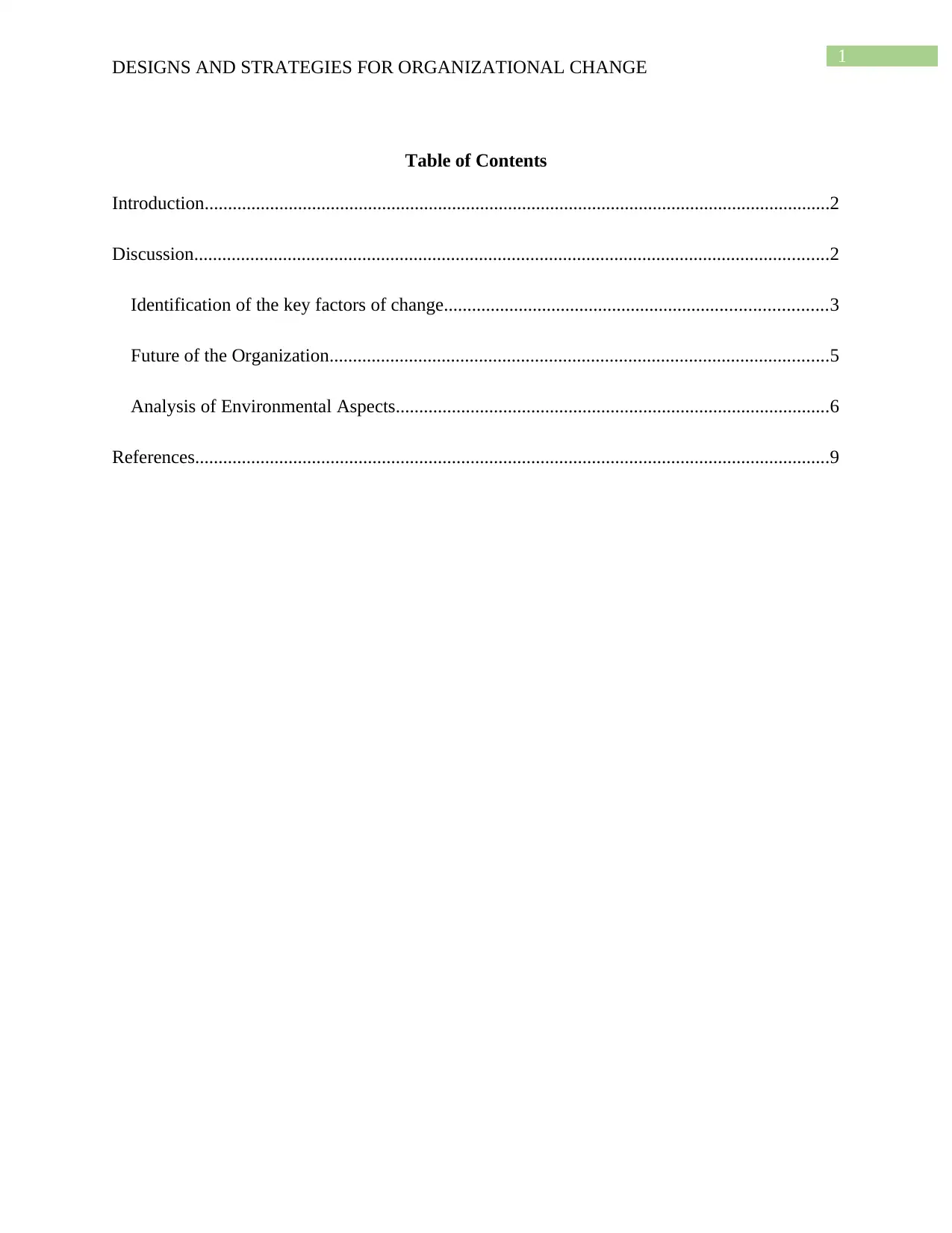
1
DESIGNS AND STRATEGIES FOR ORGANIZATIONAL CHANGE
Table of Contents
Introduction......................................................................................................................................2
Discussion........................................................................................................................................2
Identification of the key factors of change..................................................................................3
Future of the Organization...........................................................................................................5
Analysis of Environmental Aspects.............................................................................................6
References........................................................................................................................................9
DESIGNS AND STRATEGIES FOR ORGANIZATIONAL CHANGE
Table of Contents
Introduction......................................................................................................................................2
Discussion........................................................................................................................................2
Identification of the key factors of change..................................................................................3
Future of the Organization...........................................................................................................5
Analysis of Environmental Aspects.............................................................................................6
References........................................................................................................................................9
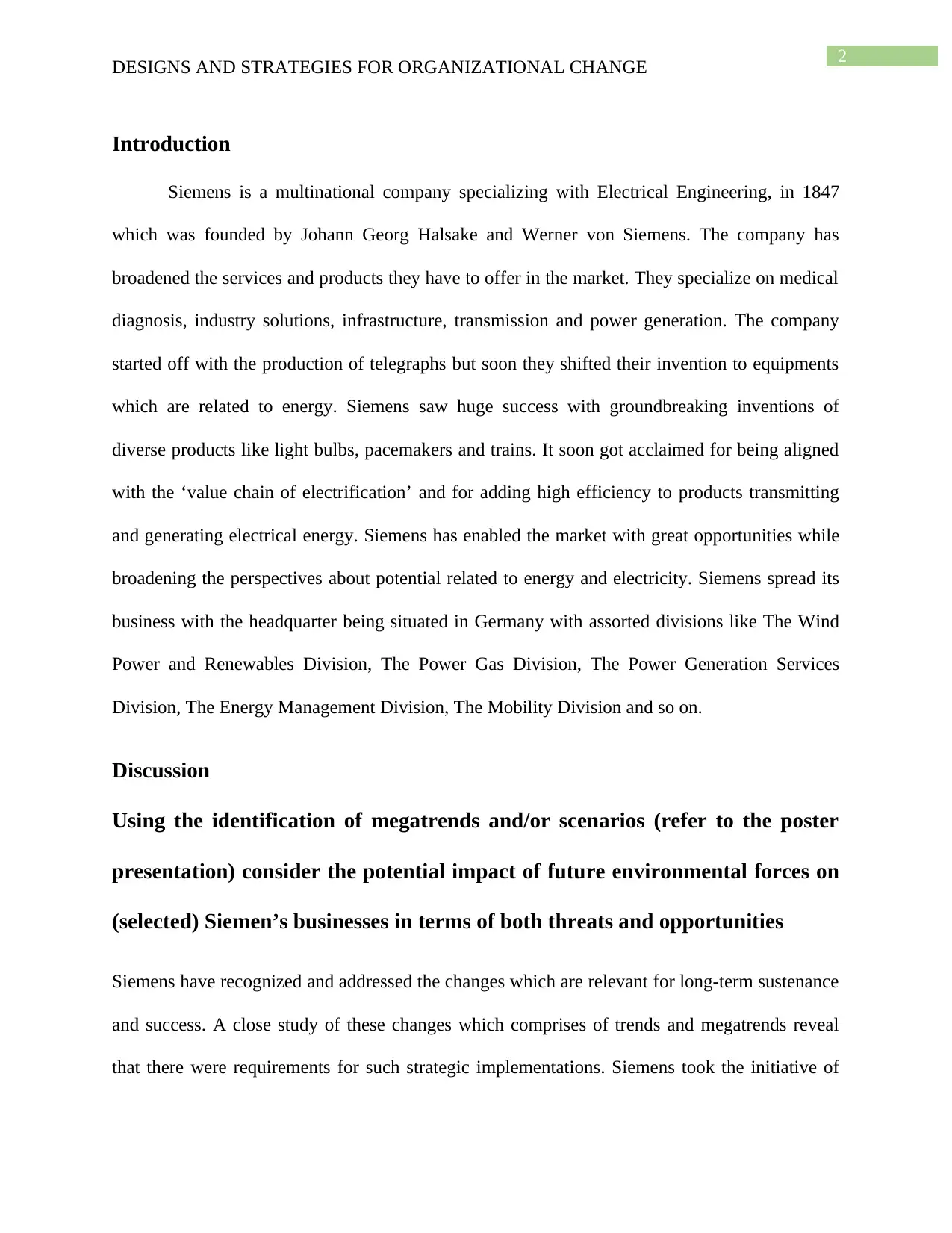
2
DESIGNS AND STRATEGIES FOR ORGANIZATIONAL CHANGE
Introduction
Siemens is a multinational company specializing with Electrical Engineering, in 1847
which was founded by Johann Georg Halsake and Werner von Siemens. The company has
broadened the services and products they have to offer in the market. They specialize on medical
diagnosis, industry solutions, infrastructure, transmission and power generation. The company
started off with the production of telegraphs but soon they shifted their invention to equipments
which are related to energy. Siemens saw huge success with groundbreaking inventions of
diverse products like light bulbs, pacemakers and trains. It soon got acclaimed for being aligned
with the ‘value chain of electrification’ and for adding high efficiency to products transmitting
and generating electrical energy. Siemens has enabled the market with great opportunities while
broadening the perspectives about potential related to energy and electricity. Siemens spread its
business with the headquarter being situated in Germany with assorted divisions like The Wind
Power and Renewables Division, The Power Gas Division, The Power Generation Services
Division, The Energy Management Division, The Mobility Division and so on.
Discussion
Using the identification of megatrends and/or scenarios (refer to the poster
presentation) consider the potential impact of future environmental forces on
(selected) Siemen’s businesses in terms of both threats and opportunities
Siemens have recognized and addressed the changes which are relevant for long-term sustenance
and success. A close study of these changes which comprises of trends and megatrends reveal
that there were requirements for such strategic implementations. Siemens took the initiative of
DESIGNS AND STRATEGIES FOR ORGANIZATIONAL CHANGE
Introduction
Siemens is a multinational company specializing with Electrical Engineering, in 1847
which was founded by Johann Georg Halsake and Werner von Siemens. The company has
broadened the services and products they have to offer in the market. They specialize on medical
diagnosis, industry solutions, infrastructure, transmission and power generation. The company
started off with the production of telegraphs but soon they shifted their invention to equipments
which are related to energy. Siemens saw huge success with groundbreaking inventions of
diverse products like light bulbs, pacemakers and trains. It soon got acclaimed for being aligned
with the ‘value chain of electrification’ and for adding high efficiency to products transmitting
and generating electrical energy. Siemens has enabled the market with great opportunities while
broadening the perspectives about potential related to energy and electricity. Siemens spread its
business with the headquarter being situated in Germany with assorted divisions like The Wind
Power and Renewables Division, The Power Gas Division, The Power Generation Services
Division, The Energy Management Division, The Mobility Division and so on.
Discussion
Using the identification of megatrends and/or scenarios (refer to the poster
presentation) consider the potential impact of future environmental forces on
(selected) Siemen’s businesses in terms of both threats and opportunities
Siemens have recognized and addressed the changes which are relevant for long-term sustenance
and success. A close study of these changes which comprises of trends and megatrends reveal
that there were requirements for such strategic implementations. Siemens took the initiative of
⊘ This is a preview!⊘
Do you want full access?
Subscribe today to unlock all pages.

Trusted by 1+ million students worldwide
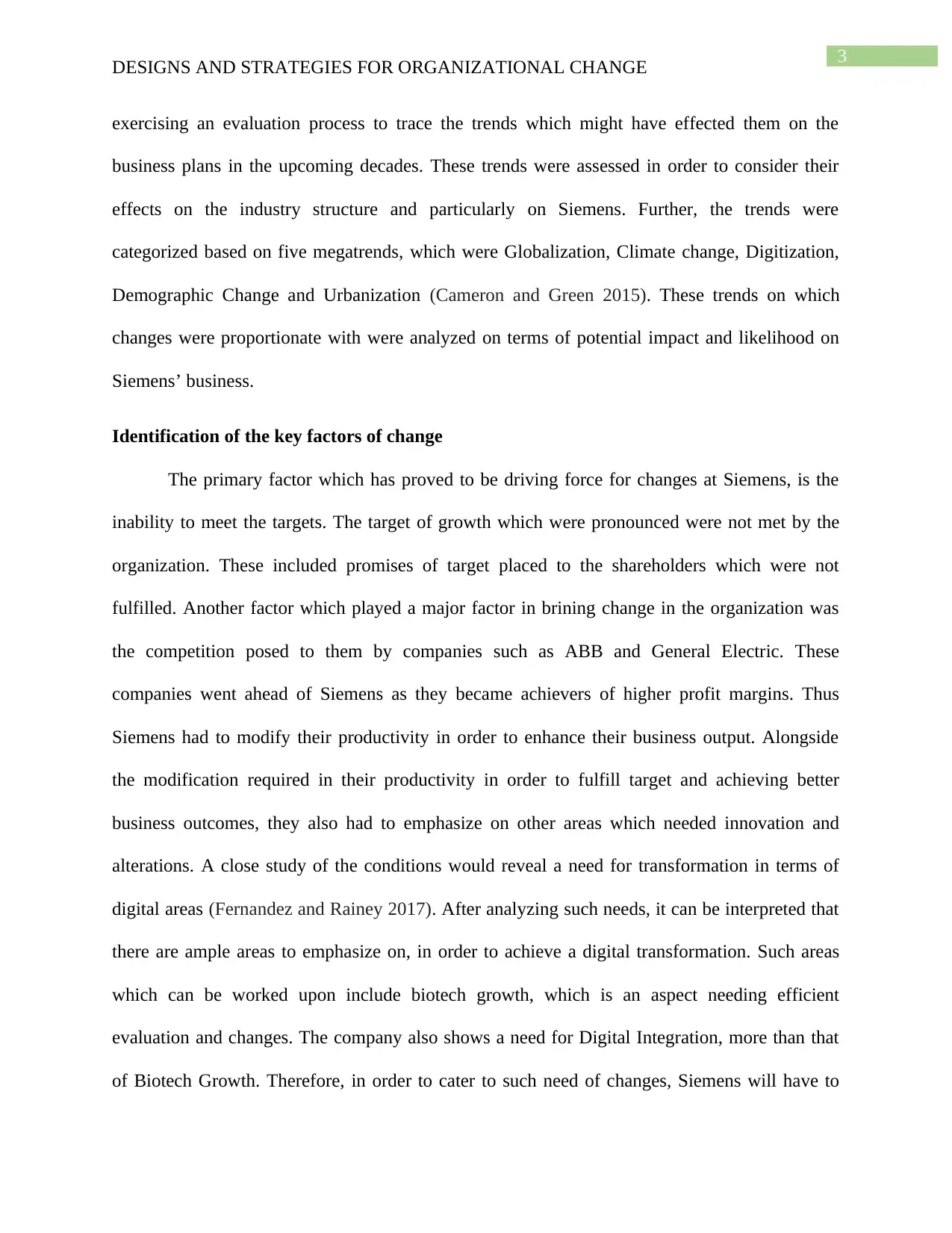
3
DESIGNS AND STRATEGIES FOR ORGANIZATIONAL CHANGE
exercising an evaluation process to trace the trends which might have effected them on the
business plans in the upcoming decades. These trends were assessed in order to consider their
effects on the industry structure and particularly on Siemens. Further, the trends were
categorized based on five megatrends, which were Globalization, Climate change, Digitization,
Demographic Change and Urbanization (Cameron and Green 2015). These trends on which
changes were proportionate with were analyzed on terms of potential impact and likelihood on
Siemens’ business.
Identification of the key factors of change
The primary factor which has proved to be driving force for changes at Siemens, is the
inability to meet the targets. The target of growth which were pronounced were not met by the
organization. These included promises of target placed to the shareholders which were not
fulfilled. Another factor which played a major factor in brining change in the organization was
the competition posed to them by companies such as ABB and General Electric. These
companies went ahead of Siemens as they became achievers of higher profit margins. Thus
Siemens had to modify their productivity in order to enhance their business output. Alongside
the modification required in their productivity in order to fulfill target and achieving better
business outcomes, they also had to emphasize on other areas which needed innovation and
alterations. A close study of the conditions would reveal a need for transformation in terms of
digital areas (Fernandez and Rainey 2017). After analyzing such needs, it can be interpreted that
there are ample areas to emphasize on, in order to achieve a digital transformation. Such areas
which can be worked upon include biotech growth, which is an aspect needing efficient
evaluation and changes. The company also shows a need for Digital Integration, more than that
of Biotech Growth. Therefore, in order to cater to such need of changes, Siemens will have to
DESIGNS AND STRATEGIES FOR ORGANIZATIONAL CHANGE
exercising an evaluation process to trace the trends which might have effected them on the
business plans in the upcoming decades. These trends were assessed in order to consider their
effects on the industry structure and particularly on Siemens. Further, the trends were
categorized based on five megatrends, which were Globalization, Climate change, Digitization,
Demographic Change and Urbanization (Cameron and Green 2015). These trends on which
changes were proportionate with were analyzed on terms of potential impact and likelihood on
Siemens’ business.
Identification of the key factors of change
The primary factor which has proved to be driving force for changes at Siemens, is the
inability to meet the targets. The target of growth which were pronounced were not met by the
organization. These included promises of target placed to the shareholders which were not
fulfilled. Another factor which played a major factor in brining change in the organization was
the competition posed to them by companies such as ABB and General Electric. These
companies went ahead of Siemens as they became achievers of higher profit margins. Thus
Siemens had to modify their productivity in order to enhance their business output. Alongside
the modification required in their productivity in order to fulfill target and achieving better
business outcomes, they also had to emphasize on other areas which needed innovation and
alterations. A close study of the conditions would reveal a need for transformation in terms of
digital areas (Fernandez and Rainey 2017). After analyzing such needs, it can be interpreted that
there are ample areas to emphasize on, in order to achieve a digital transformation. Such areas
which can be worked upon include biotech growth, which is an aspect needing efficient
evaluation and changes. The company also shows a need for Digital Integration, more than that
of Biotech Growth. Therefore, in order to cater to such need of changes, Siemens will have to
Paraphrase This Document
Need a fresh take? Get an instant paraphrase of this document with our AI Paraphraser
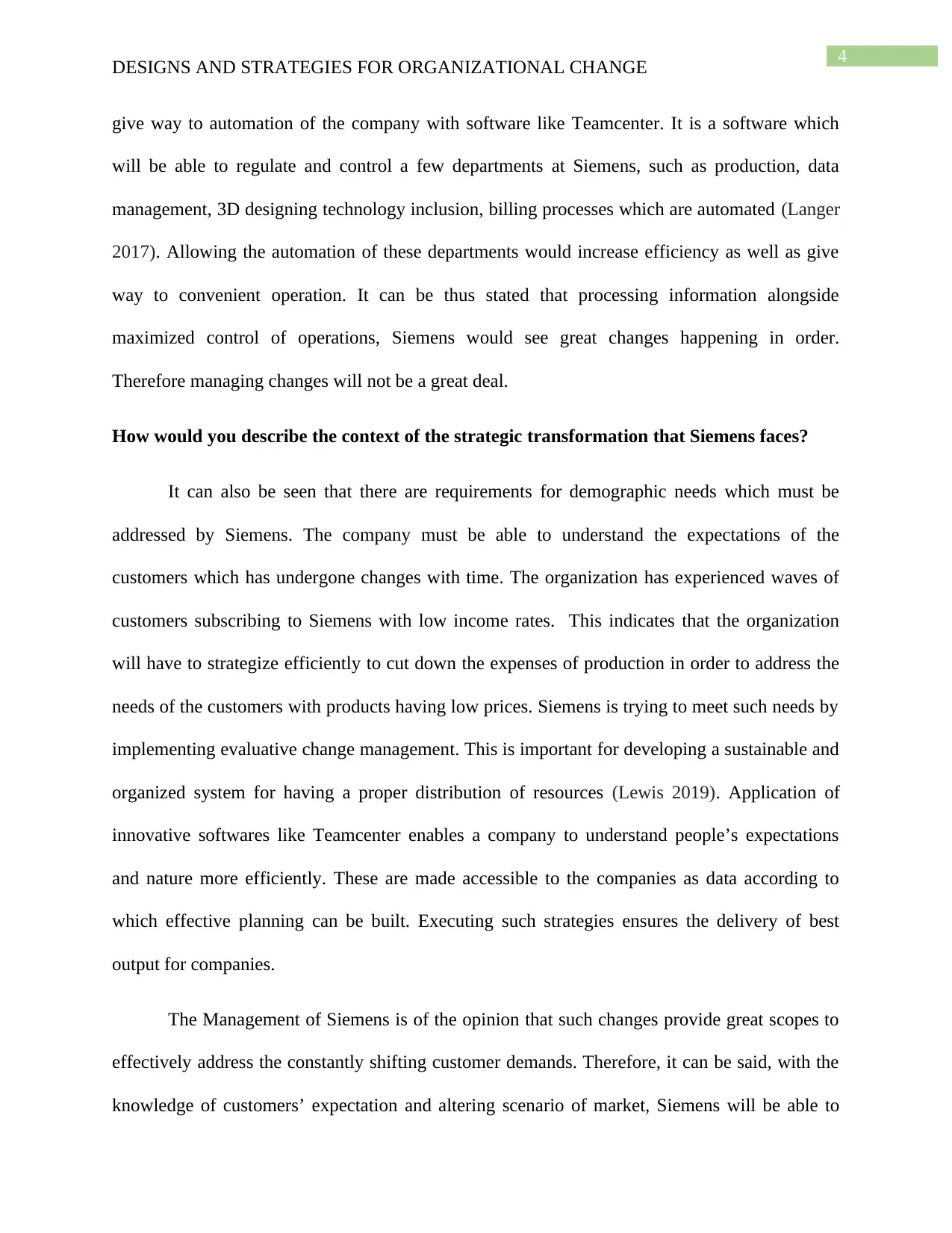
4
DESIGNS AND STRATEGIES FOR ORGANIZATIONAL CHANGE
give way to automation of the company with software like Teamcenter. It is a software which
will be able to regulate and control a few departments at Siemens, such as production, data
management, 3D designing technology inclusion, billing processes which are automated (Langer
2017). Allowing the automation of these departments would increase efficiency as well as give
way to convenient operation. It can be thus stated that processing information alongside
maximized control of operations, Siemens would see great changes happening in order.
Therefore managing changes will not be a great deal.
How would you describe the context of the strategic transformation that Siemens faces?
It can also be seen that there are requirements for demographic needs which must be
addressed by Siemens. The company must be able to understand the expectations of the
customers which has undergone changes with time. The organization has experienced waves of
customers subscribing to Siemens with low income rates. This indicates that the organization
will have to strategize efficiently to cut down the expenses of production in order to address the
needs of the customers with products having low prices. Siemens is trying to meet such needs by
implementing evaluative change management. This is important for developing a sustainable and
organized system for having a proper distribution of resources (Lewis 2019). Application of
innovative softwares like Teamcenter enables a company to understand people’s expectations
and nature more efficiently. These are made accessible to the companies as data according to
which effective planning can be built. Executing such strategies ensures the delivery of best
output for companies.
The Management of Siemens is of the opinion that such changes provide great scopes to
effectively address the constantly shifting customer demands. Therefore, it can be said, with the
knowledge of customers’ expectation and altering scenario of market, Siemens will be able to
DESIGNS AND STRATEGIES FOR ORGANIZATIONAL CHANGE
give way to automation of the company with software like Teamcenter. It is a software which
will be able to regulate and control a few departments at Siemens, such as production, data
management, 3D designing technology inclusion, billing processes which are automated (Langer
2017). Allowing the automation of these departments would increase efficiency as well as give
way to convenient operation. It can be thus stated that processing information alongside
maximized control of operations, Siemens would see great changes happening in order.
Therefore managing changes will not be a great deal.
How would you describe the context of the strategic transformation that Siemens faces?
It can also be seen that there are requirements for demographic needs which must be
addressed by Siemens. The company must be able to understand the expectations of the
customers which has undergone changes with time. The organization has experienced waves of
customers subscribing to Siemens with low income rates. This indicates that the organization
will have to strategize efficiently to cut down the expenses of production in order to address the
needs of the customers with products having low prices. Siemens is trying to meet such needs by
implementing evaluative change management. This is important for developing a sustainable and
organized system for having a proper distribution of resources (Lewis 2019). Application of
innovative softwares like Teamcenter enables a company to understand people’s expectations
and nature more efficiently. These are made accessible to the companies as data according to
which effective planning can be built. Executing such strategies ensures the delivery of best
output for companies.
The Management of Siemens is of the opinion that such changes provide great scopes to
effectively address the constantly shifting customer demands. Therefore, it can be said, with the
knowledge of customers’ expectation and altering scenario of market, Siemens will be able to
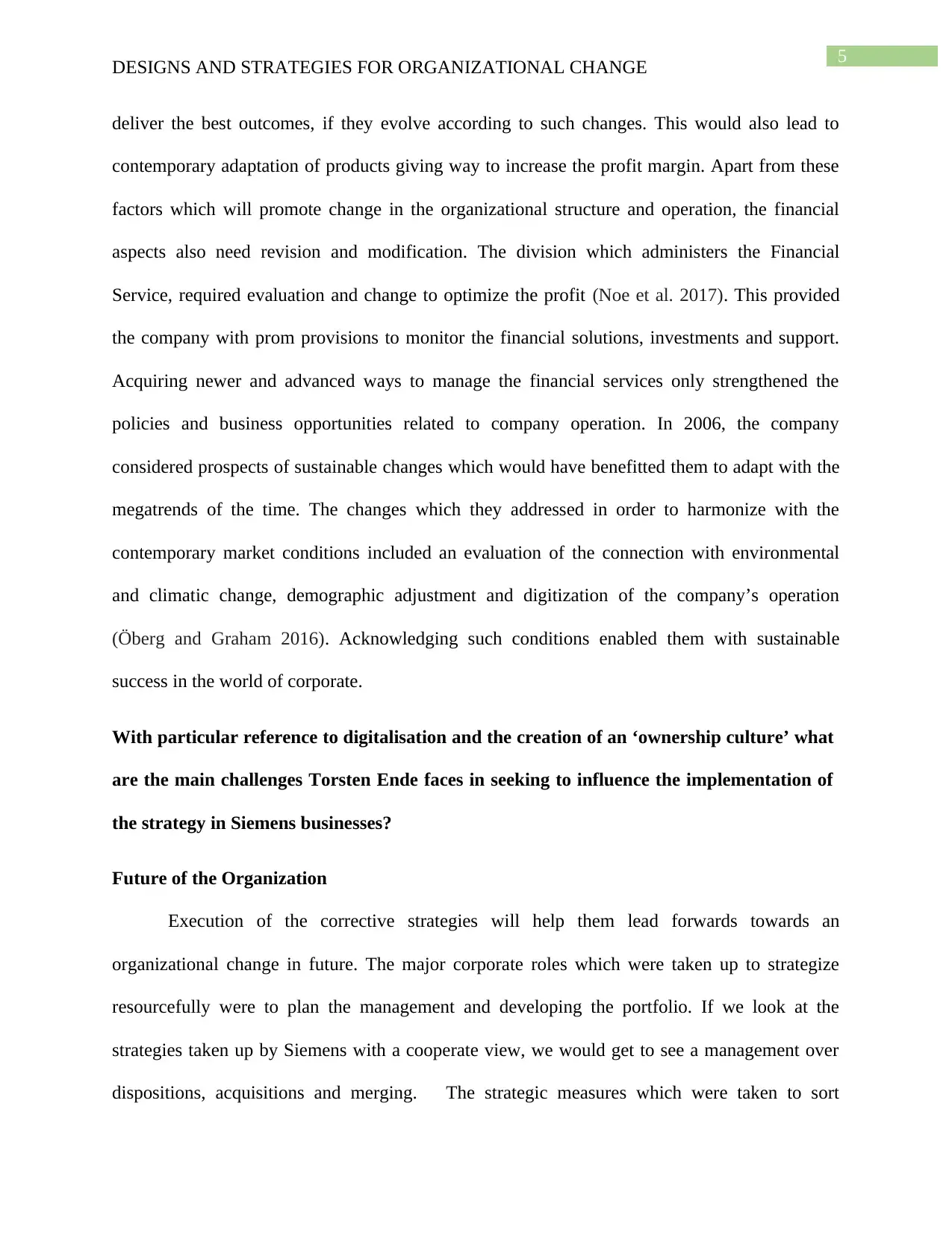
5
DESIGNS AND STRATEGIES FOR ORGANIZATIONAL CHANGE
deliver the best outcomes, if they evolve according to such changes. This would also lead to
contemporary adaptation of products giving way to increase the profit margin. Apart from these
factors which will promote change in the organizational structure and operation, the financial
aspects also need revision and modification. The division which administers the Financial
Service, required evaluation and change to optimize the profit (Noe et al. 2017). This provided
the company with prom provisions to monitor the financial solutions, investments and support.
Acquiring newer and advanced ways to manage the financial services only strengthened the
policies and business opportunities related to company operation. In 2006, the company
considered prospects of sustainable changes which would have benefitted them to adapt with the
megatrends of the time. The changes which they addressed in order to harmonize with the
contemporary market conditions included an evaluation of the connection with environmental
and climatic change, demographic adjustment and digitization of the company’s operation
(Öberg and Graham 2016). Acknowledging such conditions enabled them with sustainable
success in the world of corporate.
With particular reference to digitalisation and the creation of an ‘ownership culture’ what
are the main challenges Torsten Ende faces in seeking to influence the implementation of
the strategy in Siemens businesses?
Future of the Organization
Execution of the corrective strategies will help them lead forwards towards an
organizational change in future. The major corporate roles which were taken up to strategize
resourcefully were to plan the management and developing the portfolio. If we look at the
strategies taken up by Siemens with a cooperate view, we would get to see a management over
dispositions, acquisitions and merging. The strategic measures which were taken to sort
DESIGNS AND STRATEGIES FOR ORGANIZATIONAL CHANGE
deliver the best outcomes, if they evolve according to such changes. This would also lead to
contemporary adaptation of products giving way to increase the profit margin. Apart from these
factors which will promote change in the organizational structure and operation, the financial
aspects also need revision and modification. The division which administers the Financial
Service, required evaluation and change to optimize the profit (Noe et al. 2017). This provided
the company with prom provisions to monitor the financial solutions, investments and support.
Acquiring newer and advanced ways to manage the financial services only strengthened the
policies and business opportunities related to company operation. In 2006, the company
considered prospects of sustainable changes which would have benefitted them to adapt with the
megatrends of the time. The changes which they addressed in order to harmonize with the
contemporary market conditions included an evaluation of the connection with environmental
and climatic change, demographic adjustment and digitization of the company’s operation
(Öberg and Graham 2016). Acknowledging such conditions enabled them with sustainable
success in the world of corporate.
With particular reference to digitalisation and the creation of an ‘ownership culture’ what
are the main challenges Torsten Ende faces in seeking to influence the implementation of
the strategy in Siemens businesses?
Future of the Organization
Execution of the corrective strategies will help them lead forwards towards an
organizational change in future. The major corporate roles which were taken up to strategize
resourcefully were to plan the management and developing the portfolio. If we look at the
strategies taken up by Siemens with a cooperate view, we would get to see a management over
dispositions, acquisitions and merging. The strategic measures which were taken to sort
⊘ This is a preview!⊘
Do you want full access?
Subscribe today to unlock all pages.

Trusted by 1+ million students worldwide
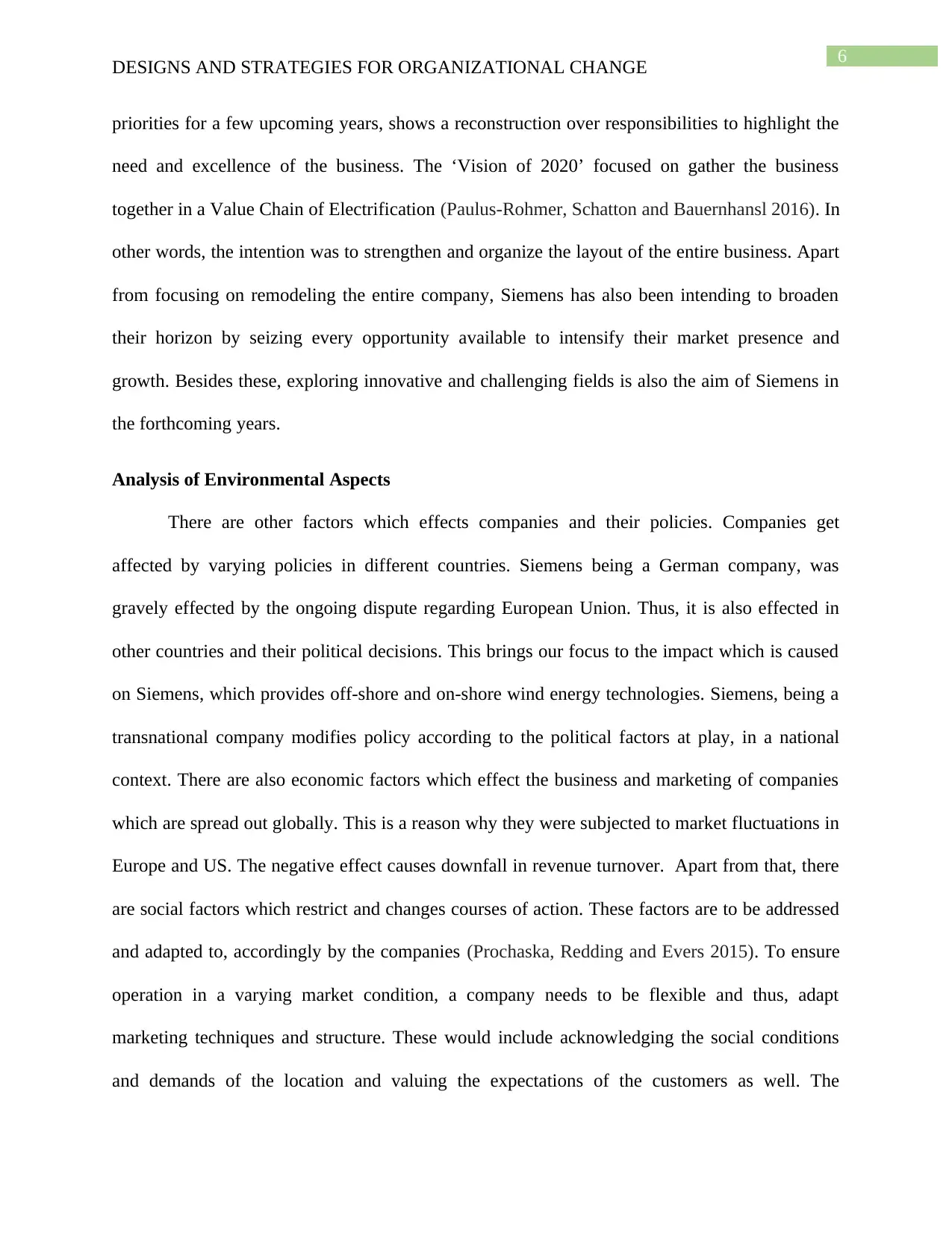
6
DESIGNS AND STRATEGIES FOR ORGANIZATIONAL CHANGE
priorities for a few upcoming years, shows a reconstruction over responsibilities to highlight the
need and excellence of the business. The ‘Vision of 2020’ focused on gather the business
together in a Value Chain of Electrification (Paulus-Rohmer, Schatton and Bauernhansl 2016). In
other words, the intention was to strengthen and organize the layout of the entire business. Apart
from focusing on remodeling the entire company, Siemens has also been intending to broaden
their horizon by seizing every opportunity available to intensify their market presence and
growth. Besides these, exploring innovative and challenging fields is also the aim of Siemens in
the forthcoming years.
Analysis of Environmental Aspects
There are other factors which effects companies and their policies. Companies get
affected by varying policies in different countries. Siemens being a German company, was
gravely effected by the ongoing dispute regarding European Union. Thus, it is also effected in
other countries and their political decisions. This brings our focus to the impact which is caused
on Siemens, which provides off-shore and on-shore wind energy technologies. Siemens, being a
transnational company modifies policy according to the political factors at play, in a national
context. There are also economic factors which effect the business and marketing of companies
which are spread out globally. This is a reason why they were subjected to market fluctuations in
Europe and US. The negative effect causes downfall in revenue turnover. Apart from that, there
are social factors which restrict and changes courses of action. These factors are to be addressed
and adapted to, accordingly by the companies (Prochaska, Redding and Evers 2015). To ensure
operation in a varying market condition, a company needs to be flexible and thus, adapt
marketing techniques and structure. These would include acknowledging the social conditions
and demands of the location and valuing the expectations of the customers as well. The
DESIGNS AND STRATEGIES FOR ORGANIZATIONAL CHANGE
priorities for a few upcoming years, shows a reconstruction over responsibilities to highlight the
need and excellence of the business. The ‘Vision of 2020’ focused on gather the business
together in a Value Chain of Electrification (Paulus-Rohmer, Schatton and Bauernhansl 2016). In
other words, the intention was to strengthen and organize the layout of the entire business. Apart
from focusing on remodeling the entire company, Siemens has also been intending to broaden
their horizon by seizing every opportunity available to intensify their market presence and
growth. Besides these, exploring innovative and challenging fields is also the aim of Siemens in
the forthcoming years.
Analysis of Environmental Aspects
There are other factors which effects companies and their policies. Companies get
affected by varying policies in different countries. Siemens being a German company, was
gravely effected by the ongoing dispute regarding European Union. Thus, it is also effected in
other countries and their political decisions. This brings our focus to the impact which is caused
on Siemens, which provides off-shore and on-shore wind energy technologies. Siemens, being a
transnational company modifies policy according to the political factors at play, in a national
context. There are also economic factors which effect the business and marketing of companies
which are spread out globally. This is a reason why they were subjected to market fluctuations in
Europe and US. The negative effect causes downfall in revenue turnover. Apart from that, there
are social factors which restrict and changes courses of action. These factors are to be addressed
and adapted to, accordingly by the companies (Prochaska, Redding and Evers 2015). To ensure
operation in a varying market condition, a company needs to be flexible and thus, adapt
marketing techniques and structure. These would include acknowledging the social conditions
and demands of the location and valuing the expectations of the customers as well. The
Paraphrase This Document
Need a fresh take? Get an instant paraphrase of this document with our AI Paraphraser
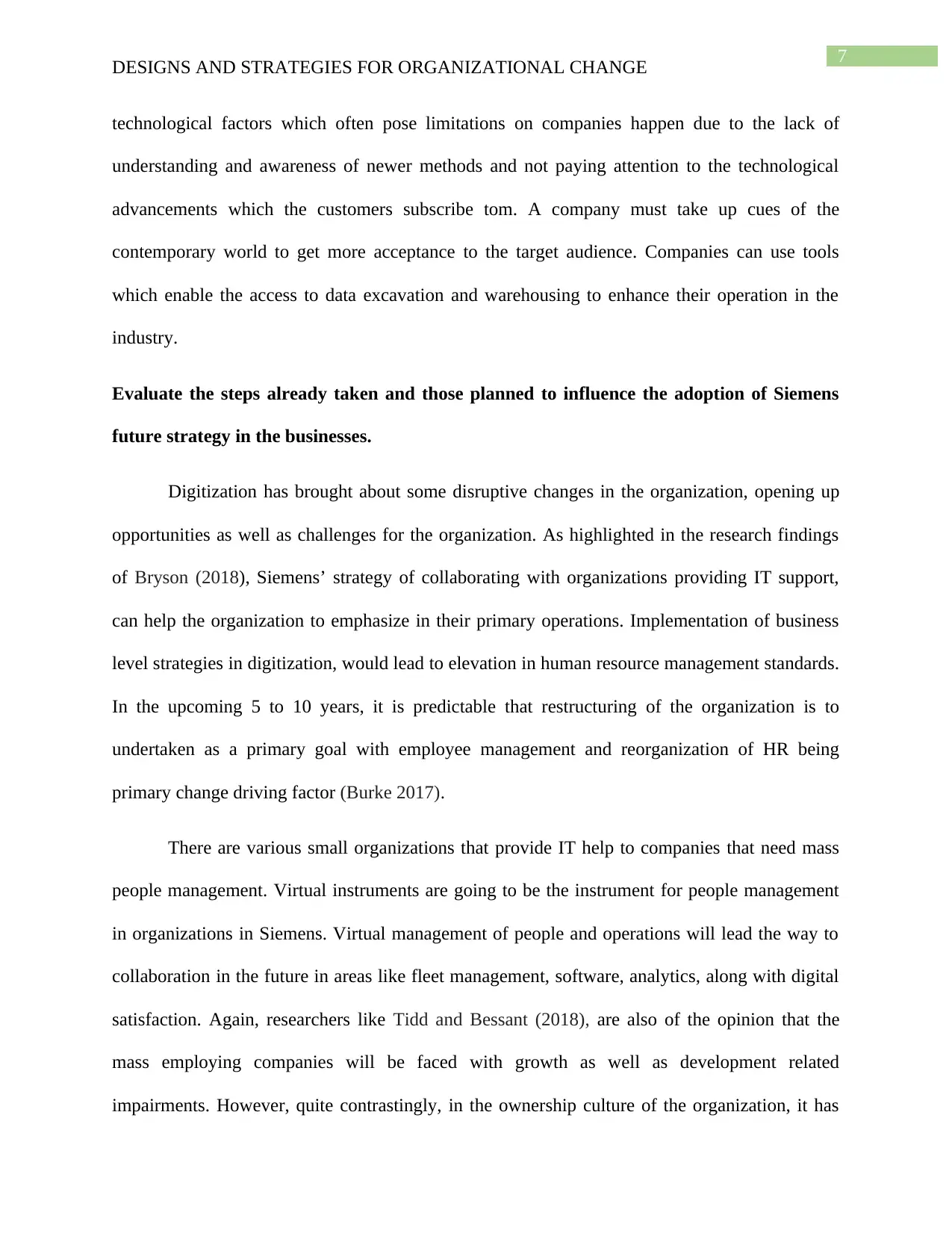
7
DESIGNS AND STRATEGIES FOR ORGANIZATIONAL CHANGE
technological factors which often pose limitations on companies happen due to the lack of
understanding and awareness of newer methods and not paying attention to the technological
advancements which the customers subscribe tom. A company must take up cues of the
contemporary world to get more acceptance to the target audience. Companies can use tools
which enable the access to data excavation and warehousing to enhance their operation in the
industry.
Evaluate the steps already taken and those planned to influence the adoption of Siemens
future strategy in the businesses.
Digitization has brought about some disruptive changes in the organization, opening up
opportunities as well as challenges for the organization. As highlighted in the research findings
of Bryson (2018), Siemens’ strategy of collaborating with organizations providing IT support,
can help the organization to emphasize in their primary operations. Implementation of business
level strategies in digitization, would lead to elevation in human resource management standards.
In the upcoming 5 to 10 years, it is predictable that restructuring of the organization is to
undertaken as a primary goal with employee management and reorganization of HR being
primary change driving factor (Burke 2017).
There are various small organizations that provide IT help to companies that need mass
people management. Virtual instruments are going to be the instrument for people management
in organizations in Siemens. Virtual management of people and operations will lead the way to
collaboration in the future in areas like fleet management, software, analytics, along with digital
satisfaction. Again, researchers like Tidd and Bessant (2018), are also of the opinion that the
mass employing companies will be faced with growth as well as development related
impairments. However, quite contrastingly, in the ownership culture of the organization, it has
DESIGNS AND STRATEGIES FOR ORGANIZATIONAL CHANGE
technological factors which often pose limitations on companies happen due to the lack of
understanding and awareness of newer methods and not paying attention to the technological
advancements which the customers subscribe tom. A company must take up cues of the
contemporary world to get more acceptance to the target audience. Companies can use tools
which enable the access to data excavation and warehousing to enhance their operation in the
industry.
Evaluate the steps already taken and those planned to influence the adoption of Siemens
future strategy in the businesses.
Digitization has brought about some disruptive changes in the organization, opening up
opportunities as well as challenges for the organization. As highlighted in the research findings
of Bryson (2018), Siemens’ strategy of collaborating with organizations providing IT support,
can help the organization to emphasize in their primary operations. Implementation of business
level strategies in digitization, would lead to elevation in human resource management standards.
In the upcoming 5 to 10 years, it is predictable that restructuring of the organization is to
undertaken as a primary goal with employee management and reorganization of HR being
primary change driving factor (Burke 2017).
There are various small organizations that provide IT help to companies that need mass
people management. Virtual instruments are going to be the instrument for people management
in organizations in Siemens. Virtual management of people and operations will lead the way to
collaboration in the future in areas like fleet management, software, analytics, along with digital
satisfaction. Again, researchers like Tidd and Bessant (2018), are also of the opinion that the
mass employing companies will be faced with growth as well as development related
impairments. However, quite contrastingly, in the ownership culture of the organization, it has
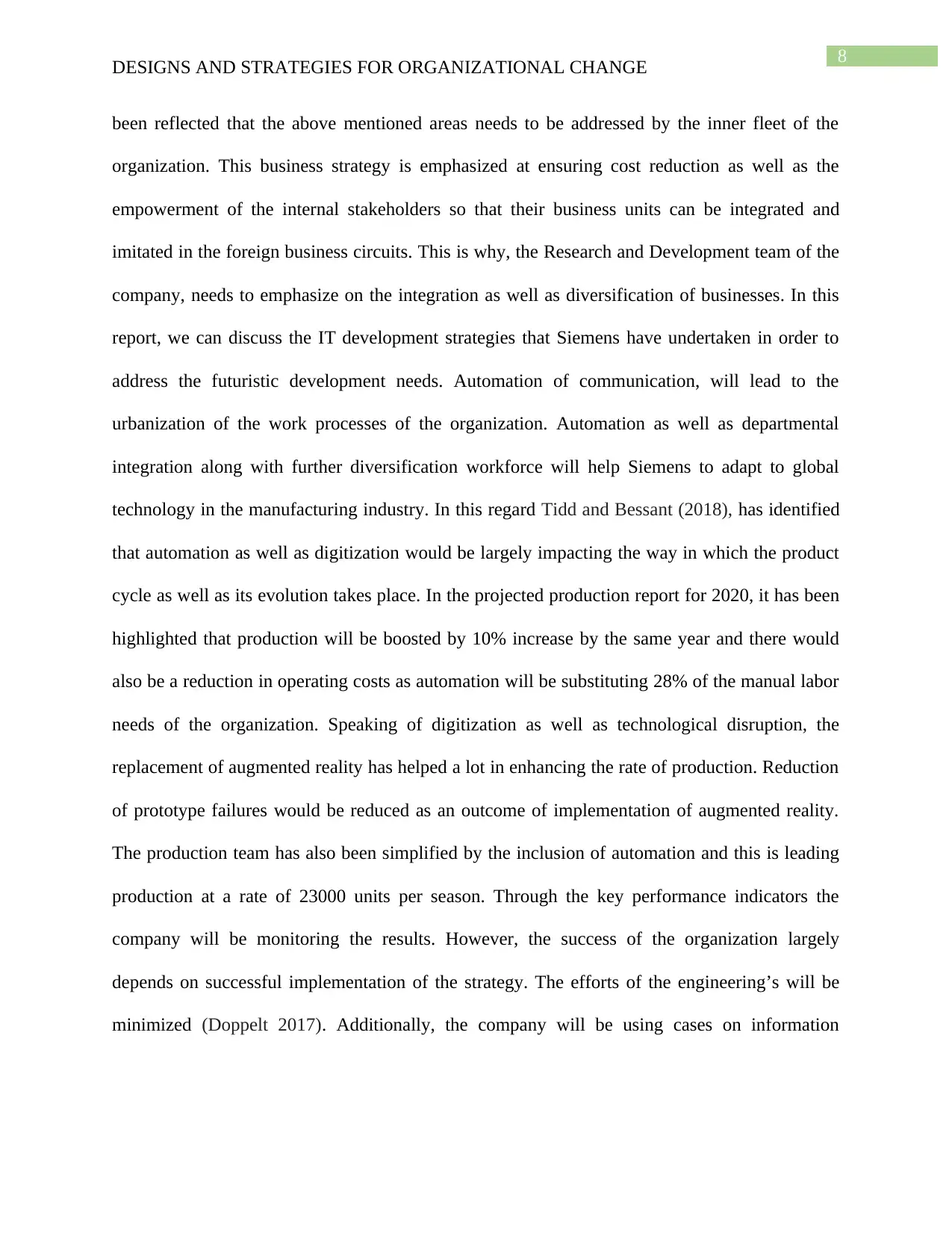
8
DESIGNS AND STRATEGIES FOR ORGANIZATIONAL CHANGE
been reflected that the above mentioned areas needs to be addressed by the inner fleet of the
organization. This business strategy is emphasized at ensuring cost reduction as well as the
empowerment of the internal stakeholders so that their business units can be integrated and
imitated in the foreign business circuits. This is why, the Research and Development team of the
company, needs to emphasize on the integration as well as diversification of businesses. In this
report, we can discuss the IT development strategies that Siemens have undertaken in order to
address the futuristic development needs. Automation of communication, will lead to the
urbanization of the work processes of the organization. Automation as well as departmental
integration along with further diversification workforce will help Siemens to adapt to global
technology in the manufacturing industry. In this regard Tidd and Bessant (2018), has identified
that automation as well as digitization would be largely impacting the way in which the product
cycle as well as its evolution takes place. In the projected production report for 2020, it has been
highlighted that production will be boosted by 10% increase by the same year and there would
also be a reduction in operating costs as automation will be substituting 28% of the manual labor
needs of the organization. Speaking of digitization as well as technological disruption, the
replacement of augmented reality has helped a lot in enhancing the rate of production. Reduction
of prototype failures would be reduced as an outcome of implementation of augmented reality.
The production team has also been simplified by the inclusion of automation and this is leading
production at a rate of 23000 units per season. Through the key performance indicators the
company will be monitoring the results. However, the success of the organization largely
depends on successful implementation of the strategy. The efforts of the engineering’s will be
minimized (Doppelt 2017). Additionally, the company will be using cases on information
DESIGNS AND STRATEGIES FOR ORGANIZATIONAL CHANGE
been reflected that the above mentioned areas needs to be addressed by the inner fleet of the
organization. This business strategy is emphasized at ensuring cost reduction as well as the
empowerment of the internal stakeholders so that their business units can be integrated and
imitated in the foreign business circuits. This is why, the Research and Development team of the
company, needs to emphasize on the integration as well as diversification of businesses. In this
report, we can discuss the IT development strategies that Siemens have undertaken in order to
address the futuristic development needs. Automation of communication, will lead to the
urbanization of the work processes of the organization. Automation as well as departmental
integration along with further diversification workforce will help Siemens to adapt to global
technology in the manufacturing industry. In this regard Tidd and Bessant (2018), has identified
that automation as well as digitization would be largely impacting the way in which the product
cycle as well as its evolution takes place. In the projected production report for 2020, it has been
highlighted that production will be boosted by 10% increase by the same year and there would
also be a reduction in operating costs as automation will be substituting 28% of the manual labor
needs of the organization. Speaking of digitization as well as technological disruption, the
replacement of augmented reality has helped a lot in enhancing the rate of production. Reduction
of prototype failures would be reduced as an outcome of implementation of augmented reality.
The production team has also been simplified by the inclusion of automation and this is leading
production at a rate of 23000 units per season. Through the key performance indicators the
company will be monitoring the results. However, the success of the organization largely
depends on successful implementation of the strategy. The efforts of the engineering’s will be
minimized (Doppelt 2017). Additionally, the company will be using cases on information
⊘ This is a preview!⊘
Do you want full access?
Subscribe today to unlock all pages.

Trusted by 1+ million students worldwide
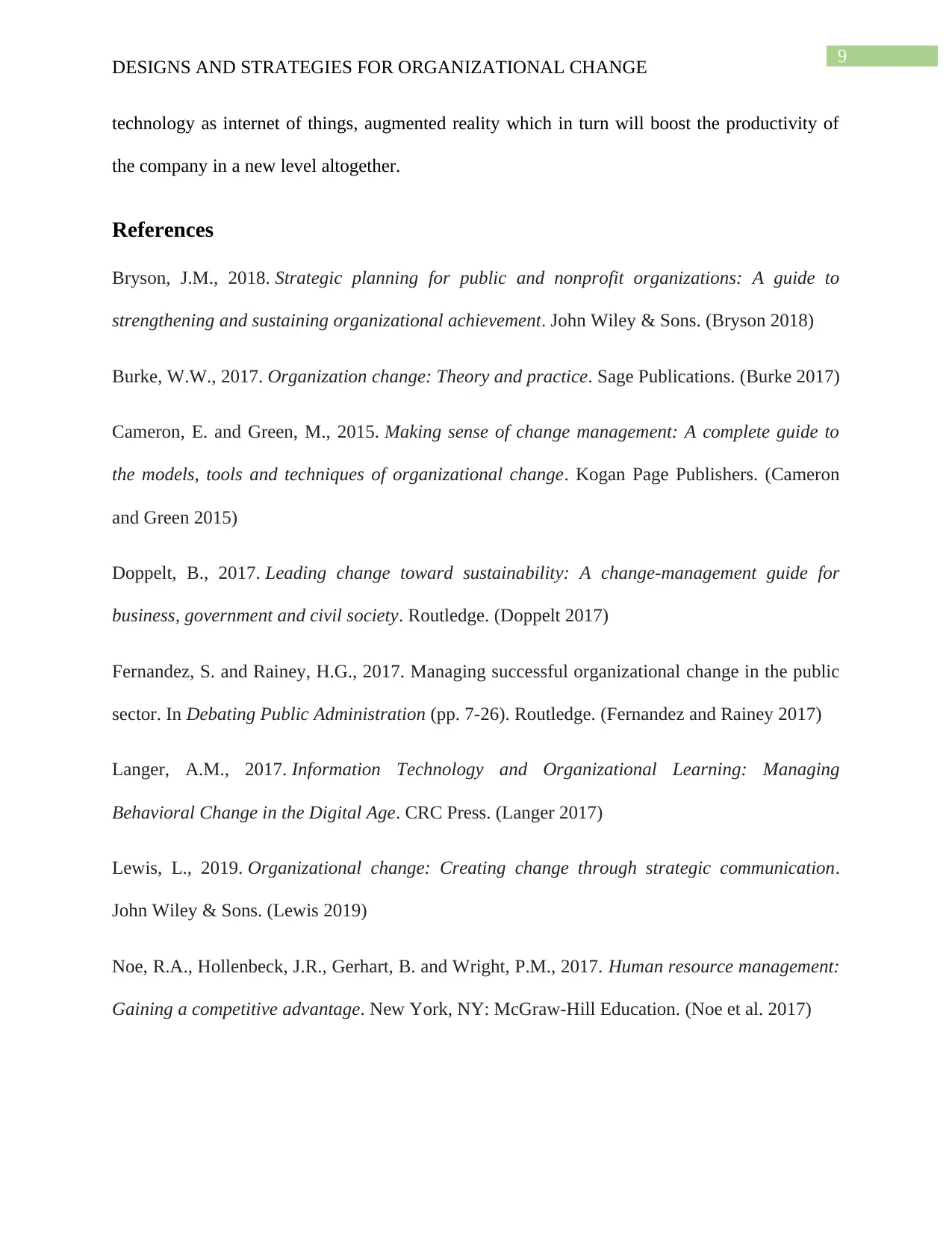
9
DESIGNS AND STRATEGIES FOR ORGANIZATIONAL CHANGE
technology as internet of things, augmented reality which in turn will boost the productivity of
the company in a new level altogether.
References
Bryson, J.M., 2018. Strategic planning for public and nonprofit organizations: A guide to
strengthening and sustaining organizational achievement. John Wiley & Sons. (Bryson 2018)
Burke, W.W., 2017. Organization change: Theory and practice. Sage Publications. (Burke 2017)
Cameron, E. and Green, M., 2015. Making sense of change management: A complete guide to
the models, tools and techniques of organizational change. Kogan Page Publishers. (Cameron
and Green 2015)
Doppelt, B., 2017. Leading change toward sustainability: A change-management guide for
business, government and civil society. Routledge. (Doppelt 2017)
Fernandez, S. and Rainey, H.G., 2017. Managing successful organizational change in the public
sector. In Debating Public Administration (pp. 7-26). Routledge. (Fernandez and Rainey 2017)
Langer, A.M., 2017. Information Technology and Organizational Learning: Managing
Behavioral Change in the Digital Age. CRC Press. (Langer 2017)
Lewis, L., 2019. Organizational change: Creating change through strategic communication.
John Wiley & Sons. (Lewis 2019)
Noe, R.A., Hollenbeck, J.R., Gerhart, B. and Wright, P.M., 2017. Human resource management:
Gaining a competitive advantage. New York, NY: McGraw-Hill Education. (Noe et al. 2017)
DESIGNS AND STRATEGIES FOR ORGANIZATIONAL CHANGE
technology as internet of things, augmented reality which in turn will boost the productivity of
the company in a new level altogether.
References
Bryson, J.M., 2018. Strategic planning for public and nonprofit organizations: A guide to
strengthening and sustaining organizational achievement. John Wiley & Sons. (Bryson 2018)
Burke, W.W., 2017. Organization change: Theory and practice. Sage Publications. (Burke 2017)
Cameron, E. and Green, M., 2015. Making sense of change management: A complete guide to
the models, tools and techniques of organizational change. Kogan Page Publishers. (Cameron
and Green 2015)
Doppelt, B., 2017. Leading change toward sustainability: A change-management guide for
business, government and civil society. Routledge. (Doppelt 2017)
Fernandez, S. and Rainey, H.G., 2017. Managing successful organizational change in the public
sector. In Debating Public Administration (pp. 7-26). Routledge. (Fernandez and Rainey 2017)
Langer, A.M., 2017. Information Technology and Organizational Learning: Managing
Behavioral Change in the Digital Age. CRC Press. (Langer 2017)
Lewis, L., 2019. Organizational change: Creating change through strategic communication.
John Wiley & Sons. (Lewis 2019)
Noe, R.A., Hollenbeck, J.R., Gerhart, B. and Wright, P.M., 2017. Human resource management:
Gaining a competitive advantage. New York, NY: McGraw-Hill Education. (Noe et al. 2017)
Paraphrase This Document
Need a fresh take? Get an instant paraphrase of this document with our AI Paraphraser
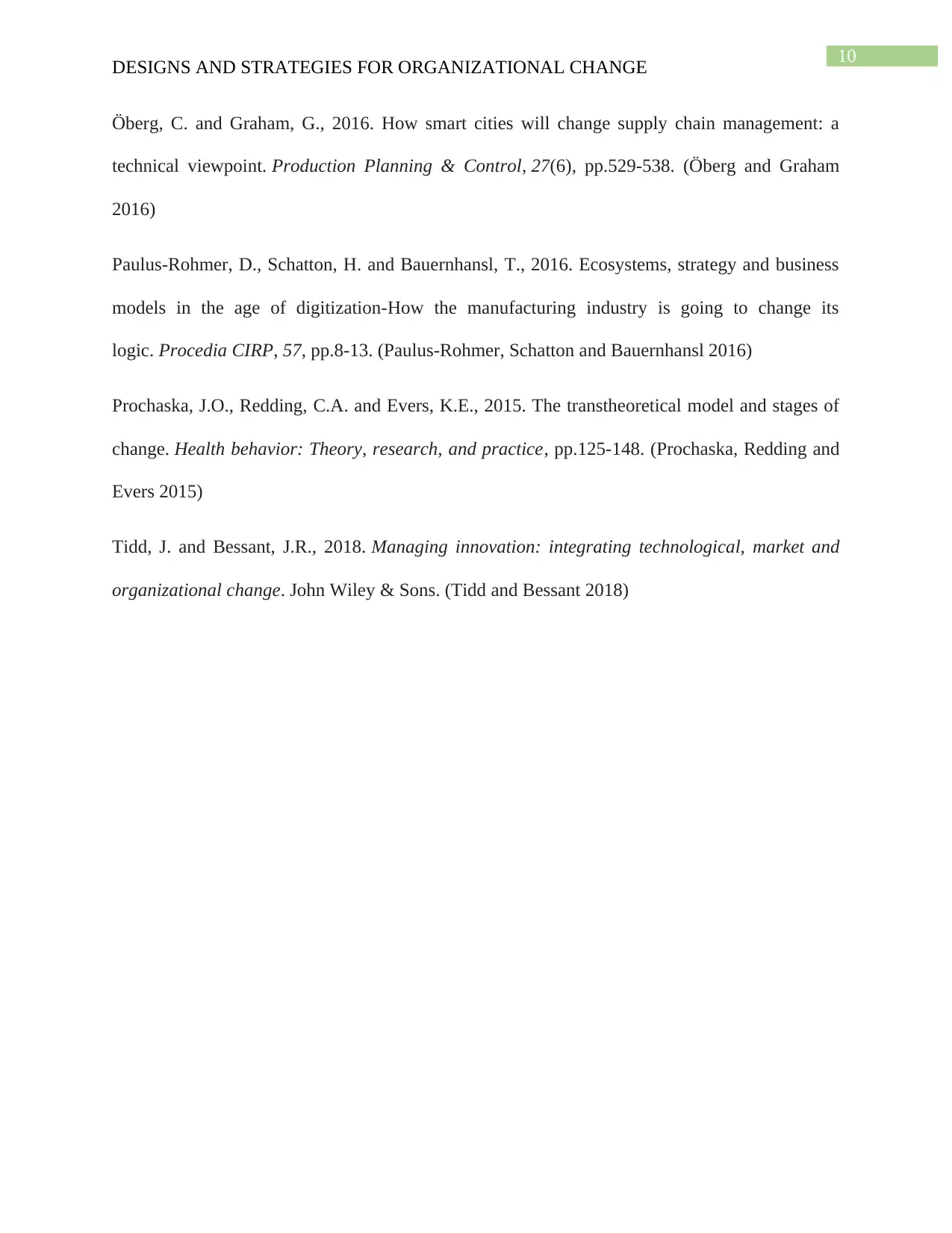
10
DESIGNS AND STRATEGIES FOR ORGANIZATIONAL CHANGE
Öberg, C. and Graham, G., 2016. How smart cities will change supply chain management: a
technical viewpoint. Production Planning & Control, 27(6), pp.529-538. (Öberg and Graham
2016)
Paulus-Rohmer, D., Schatton, H. and Bauernhansl, T., 2016. Ecosystems, strategy and business
models in the age of digitization-How the manufacturing industry is going to change its
logic. Procedia CIRP, 57, pp.8-13. (Paulus-Rohmer, Schatton and Bauernhansl 2016)
Prochaska, J.O., Redding, C.A. and Evers, K.E., 2015. The transtheoretical model and stages of
change. Health behavior: Theory, research, and practice, pp.125-148. (Prochaska, Redding and
Evers 2015)
Tidd, J. and Bessant, J.R., 2018. Managing innovation: integrating technological, market and
organizational change. John Wiley & Sons. (Tidd and Bessant 2018)
DESIGNS AND STRATEGIES FOR ORGANIZATIONAL CHANGE
Öberg, C. and Graham, G., 2016. How smart cities will change supply chain management: a
technical viewpoint. Production Planning & Control, 27(6), pp.529-538. (Öberg and Graham
2016)
Paulus-Rohmer, D., Schatton, H. and Bauernhansl, T., 2016. Ecosystems, strategy and business
models in the age of digitization-How the manufacturing industry is going to change its
logic. Procedia CIRP, 57, pp.8-13. (Paulus-Rohmer, Schatton and Bauernhansl 2016)
Prochaska, J.O., Redding, C.A. and Evers, K.E., 2015. The transtheoretical model and stages of
change. Health behavior: Theory, research, and practice, pp.125-148. (Prochaska, Redding and
Evers 2015)
Tidd, J. and Bessant, J.R., 2018. Managing innovation: integrating technological, market and
organizational change. John Wiley & Sons. (Tidd and Bessant 2018)
1 out of 11
Related Documents
Your All-in-One AI-Powered Toolkit for Academic Success.
+13062052269
info@desklib.com
Available 24*7 on WhatsApp / Email
![[object Object]](/_next/static/media/star-bottom.7253800d.svg)
Unlock your academic potential
Copyright © 2020–2025 A2Z Services. All Rights Reserved. Developed and managed by ZUCOL.





